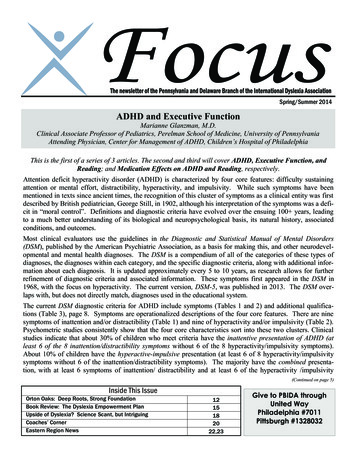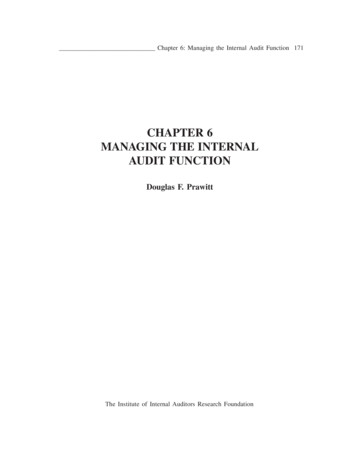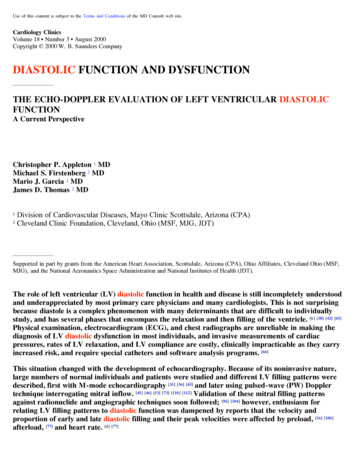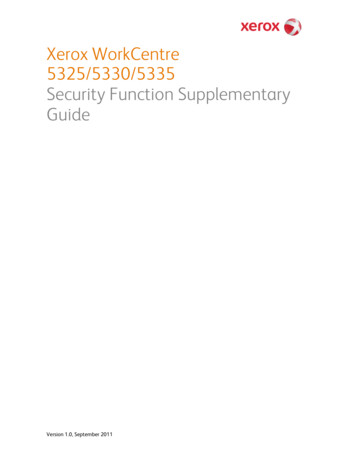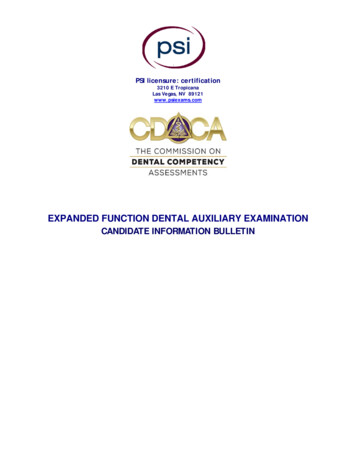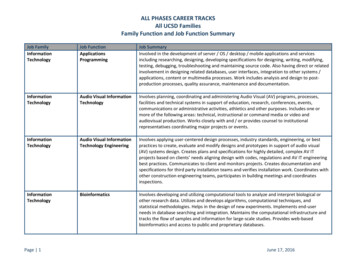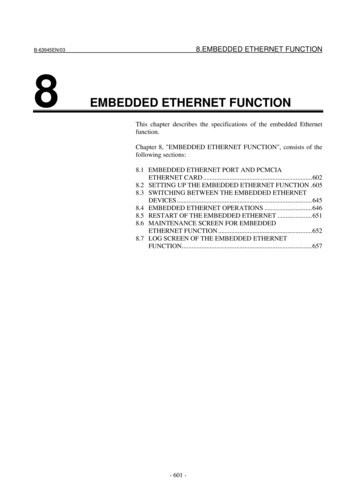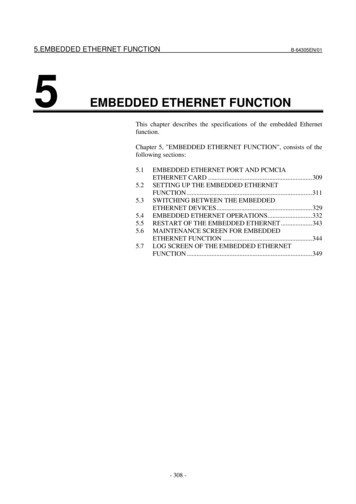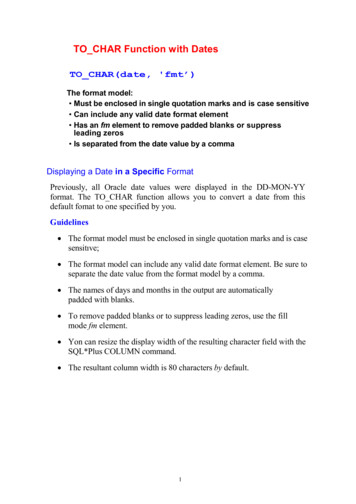
Transcription
Executive Function in the Classroom: NeurologicalImplications for ClassroomInterventionHarriet Greenstone, Centre MDCABSTRACTExecutive function skills are critical for both school and personal success, but havebeen traditionally under-addressed in academic settings. Recent advances in the fieldof neuroscience, and specifically those dealing with neuroplasticity, have providednew understanding of the causes of executive dysfunction and how we can use thisinformation to remediate these weaknesses in the classroom, even for those with typical executive function development, by teaching these skills as part of the curriculum.IntroductionDespite increased efforts in recent years toward zero tolerance for aggression, oppositional behaviour, and bullying, these behaviours persist in ourclassrooms. And despite our many pedagogical and curricular advances,too many students are still not completing high school, or are graduating without theskill sets necessary to succeed in post-secondary studies.This article proposes that although educators may be aware of executivefunction skills, they may be overlooking their important implication in the foundation(and thus the remediation) of both academic and behavioural problems. Executivefunction skills are a collection of skills that are critical for goal-directed behaviours,social behaviours, and emotional well-being. It’s hard to imagine being successful inthe classroom, or indeed in life, without them. They are at least as important as reading and mathematics skills, arguably even more important, yet while progress hasLEARNing Landscapes Vol. 5, No. 1, Autumn 2011101
Harriet Greenstonebeen made in the research domain for executive functioning, much less is being seenin practice.There is no definitive list of what constitutes executive function skills. Researchers generally agree on the content, but there is often overlap and differentiallabelling of the various skills. A good working model can be found in the BehaviorRating Inventory of Executive Function (BRIEF; Gioia, Isquith, Guy, & Kenworthy, 2000),which measures the executive function domains shown in the table below.Table 1Executive Function Domains (BRIEF)102DomainDescriptionInhibitAbility to resist impulses and inhibit one’s behaviour when appropriate.ShiftAbility to switch attention, deal with transitions and toleratechange, think flexibly, shift focus.Emotional controlAbility to control or modify one’s emotional responses.InitiateAbility to start an activity or task, to come up with one’s ownideas and problem-solving approaches.Working MemoryAbility to retain information in one’s memory and actively useor manipulate it to complete a task (e.g., to follow complex instructions, or do multi-step activities such as mental arithmetic).Plan/OrganizeAbility to set goals, anticipate future developments, predetermine steps necessary to complete a goal, organize information, identify key concepts or ideas, employ complex (oreven simple) motor planning.Organization ofmaterialsAbility to keep track of one’s materials and belongings andmaintain them in an organized state, available for use whenneeded.MonitorAbility to assess one’s progress on a task (monitoring accuracy,time management, effectiveness of strategies, etc.) and ultimate performance on the task, and the ability to monitor one’sbehaviours and the effect they have on others.LEARNing Landscapes Vol. 5, No. 1, Autumn 2011
Executive Function in the Classroom: Neurological Implications for Classroom InterventionExecutive Dysfunction: A Neurological Problem,Not a Character FlawThe frontal lobe, often referred to as the brain’s “control centre,” is considered the seat of executive functioning. This is where the anterior cingulate is located,which is often referred to as the “oops centre” because of its role in helping us anticipate risks and keeping us from acting in a way that is detrimental or inappropriate.This structure in the brain has been associated with many executive function skills,including emotional self-control, problem solving, divided attention, recognizing errors or conflicting information, and adaptive behaviour in changing circumstances(Allman, Hakeem, Erwin, Nimchinsky, & Hof, 2001; Powell & Voeller, 2004 ). Althoughthe anterior cingulate is not the only part of the brain involved in executive functionskills, its role is essential, and demonstrates that the roots of executive dysfunction liein the brain, not in character flaws.It’s not surprising that a glitch in the neural circuitry of the frontal lobe canlead to problems in many areas of executive functioning—just as there are neurological, neuropsychological, and/or neurochemical underpinnings to many otherdisorders, including learning disabilities, ADHD, Obsessive Compulsive Disorder, Autism Spectrum Disorders, etcetera (all disorders with which executive function weak nesses are commonly associated).What is surprising, however, is the disparate response to executive dysfunction in the classroom, relative to the specialized instruction techniques and otherinterventions that have been devised to help students with these other disorders.We certainly don’t punish a child with dyslexia. But as Harvard psychologist Dr. RossGreene (2009) points out in his book Lost at School, children with weak organizational,behavioural, or emotional skills are often met with discipline or consequences, eventhough they may not know what they have done wrong or how to do it right.Hopefully, just as we no longer blame “refrigerator mothers” for autism, ordemand that learning-disabled students “try harder!,” our growing understanding ofthe neurological basis for executive dysfunction will lead to effective classroom interventions to help these students (and indeed even neurologically typical students)reach their academic and personal potential.LEARNing Landscapes Vol. 5, No. 1, Autumn 2011103
Harriet GreenstoneHow to Know if a Student Has Weak Executive Function SkillsUnfortunately, most students don’t show up on the first day of school,clutching a pencil in one hand and a full psycho-educational report in the other. Andeven if they do, and you’re lucky enough to find they have been tested for executivefunctioning, there’s a caveat. Many measures test for a well-circumscribed and smallsubset of executive function skills, so the results cannot be generalized across thewhole span of skills. You must also keep in mind that such testing can include detailedinstructions (often repeated), ongoing feedback, and significant external structure.Also, such tests are typically administered in a private office, in a relatively stress-freeenvironment, with only one supportive adult present. This is the best possible scenario for many children and adolescents with executive function difficulties, and onewhere they’re very likely to do their best. These tests don’t pretend to measure thewhole range of the individual’s executive skills, captured in a normal daily environment. And even when results do identify specific executive function weaknesses, theyare often misunderstood, considered too small and specific to be of consequence, orbeyond the scope of classroom intervention.Broader, more “real life” measures can be obtained through behaviour ratingsquestionnaires completed by parents or caregivers, teachers, and even the studentsthemselves if they are old enough. But by definition, these ratings are subjective.All these findings can be helpful, but they should be augmented by a teacher’s own observations in the classroom—and in many cases, that will be all there is togo on. Table 2 shows how weaknesses in some aspects of executive function mightappear in school-aged children. Several of these skills are behavioural in nature, andothers are metacognitive. An individual may be weak in some skills and competent oreven strong in others. The weaknesses may be “stand-alone” or part of a mix of otherdifficulties. But whatever the presentation, the classroom challenges are the same.Table 2Classroom ManifestationsProblems with Might look like this Inhibit 104Impulsivity — will often start on an activity before listening to instructionsDifficulty staying in line when moving around the school,or even staying in the classroomInterrupting others or calling out in classNeeding more adult supervision and structureLEARNing Landscapes Vol. 5, No. 1, Autumn 2011
Executive Function in the Classroom: Neurological Implications for Classroom InterventionProblems with Might look like this Shift Difficulty changing tasks, places, approaches to problemsDifficulty tolerating change (like a substitute teacher, or achange in a planned activity)Black and white thinking, can’t see the grays, can’t let go(not won’t let go an important distinction)Emotional control Outbursts, sudden/frequent mood changes, emotionallyreactive, periods of excessive emotional upsetInitiate Needs to be told to start a task, even if they’re willing todo itReady to start a task, but doesn’t know where to begin(i.e., doesn’t know the first step, needs to have the stepsbroken down)Has trouble coming up with ideas (for a project, or evenwhat to do in play time)Rarely takes initiative in chores or homework (doesn’tknow how) Working memory Plan/organize Trouble remembering things (phone numbers, instructions)Losing track of what they’re doingForgetting the purpose of an errandFrequently failing to stick to an activity (poor sustainedattention)Underestimating time to complete a task, or level of difficultyWaiting to the last minute to begin a big projectMixes up the steps involved in a project, or in any multistep sequenceFailing to understand main points in written or verbal materialLosing track of homework assignmentsGetting caught up in details and losing track of the “bigpicture”LEARNing Landscapes Vol. 5, No. 1, Autumn 2011105
Harriet GreenstoneProblems with Might look like this Organization ofmaterials Monitor Trouble keeping school materials/belongings organizedLeaving thing at home that should be at school, and viceversaLocker/desk/schoolbag is a messFrequently losing thingsFailure to have materials ready for projects/assignmentsDifficulty assessing their own performance after finishinga task, assessing what works and what doesn’t workDifficulty recognizing and keeping track of the effect theirbehaviours have on othersDeficits in executive function have additional implications, beyond theclassroom manifestations described in Table 2. For example, Elizabeth Kelley, Assistant Professor of Developmental Psychology at Kingston’s Queens University, foundthat the emotional control measure of the BRIEF was identified as a significant predictor of being bullied, because a child with weak emotional control is so reactive (ascited in MacReady, 2011). A student with poor inhibitory and emotional control, whodoesn’t grasp the effect of his or her behaviours on others, will likely have impairedsocial skills. A student with weaknesses in working memory, organization, and theability to plan and initiate tasks is likely to have deficits in such academic enablers asstudy skills, motivation, and/or engagement—which have been linked to academicsuccess (DiPerna & Elliott, 2002).Neuroplasticity and Remediationof Executive DysfunctionChildren with deficits in attention, memory, learning, etcetera have traditionally been treated with school accommodations, medication when appropriate,and strategies and therapies designed to modify these weaknesses or at least teachthe child to understand and manage them. These are all effective, and will continueto be a vital part of any intervention plan.106LEARNing Landscapes Vol. 5, No. 1, Autumn 2011
Executive Function in the Classroom: Neurological Implications for Classroom InterventionBut now, thanks to recent advances in the field of neuroscience, we can addto our repertoire of helpful interventions, even for such traditionally challenging areas as emotional regulation and lack of inhibitory control. Researchers like Canadianpsychiatrist Norman Doidge have promulgated the notion of neuroplasticity, andprovided new understanding of how the brain works. We now know that the rightexercises and activities can build new circuitry in the brain, and strengthen areas ofidentified weaknesses. Essentially, the brain can learn to bypass neural pathways thataren’t working and build new ones—not just in childhood, but through adolescenceand even adulthood (Doidge, 2007).In fact, fMRI studies indicate that some neurological functions, such as emotion processing and cognitive appraisal systems, only develop around the time ofpuberty. British researchers Blakemore and Choudhury (2006) speculated that thesefindings point to “a period of synaptic reorganisation” when adolescent brains mightbe particularly responsive to efforts to regulate executive function and social cognition.Such efforts were the subject of a study by researchers Meltzer, Pollica, andBarzillai (2007), who examined methods of teaching executive function processessuch as study skills in the classroom. In addition to providing many specific strategies,they proposed the following Principles of Effective Strategy Instruction: “Strategies for teaching executive function processes should be directly linked with the curriculum”—which appears to be more effective thanwhen these skills are taught in isolation and are unrelated to the students’classroom work. Even if a student is participating in an extra-curricular studyskills program, this could still be accomplished by the teacher and tutor collaborating, to ensure the material being used is based on current classroomsubjects. “Metacognitive strategies should be taught explicitly”—using very literaland concrete terms, and including frequent modeling and repetition. It isimportant to also teach the students exactly how each strategy will helpthem (e.g., “This strategy will help you identify the key points in any text”). “Strategies should be taught in a structured, systematic way”—again, incorporating frequent modeling, feedback, and opportunities for repeatedpractice, in order for these skills to be internalized and generalized. It isimportant to recognize that individual strategies are not “one size fits all.”LEARNing Landscapes Vol. 5, No. 1, Autumn 2011107
Harriet GreenstoneWhat works for one student might not work for another. Students shouldbe encouraged to recognize what works best for them, so strategies can beadapted accordingly. “Strategy instruction should address students’ motivation and effort”—Itis critically important for students to (a) understand their own strengths andweaknesses, and (b) see that these strategies will lead to improved grades.Without either component, they are unlikely to use them. Step (a) can bechallenging, when dealing with a student who has experienced years of failure and frustration and might be emotionally fragile. It is best accomplishedin private discussions, with equal emphasis on both strengths and weaknesses, delivered in a clearly supportive, non-judgmental manner. A goodapproach to Step (b) would be to break down tasks or assignments intosmall, accomplishable units, so the students can experience successes andbuild on them.Meltzer et al. also stressed the importance of developing a “culture of strategy use” in the classroom, by using methods such as encouraging students to keepindividual notebooks of strategies that have worked best for them, and teachersgrading students not just on the final results of tests or assignments, but also on thestrategies they used to achieve them.This approach to strategic learning is a natural fit with the work of StanfordUniversity’s Carol Dweck (2008). She believes that students who understand that brainpower is dynamic (i.e., that it can be exercised and strengthened) fare better academically than those who believe their intellectual abilities were determined at birth andcannot be altered. The approaches she advocates, such as teaching students howbrain exercises can stimulate neural growth (and improved grades), also strengthenimportant executive function skills like cognitive flexibility and self-monitoring.Some specific strategies that may be taught to and employed by all students,not just those with executive dysfunction, would include time and work organizers,colour-coded and/or sectioned notebooks, calendars to keep track of deadlines andmonitor progress, task analysis checklists, memory aids such as mnemonics, an understanding of whether they are strong auditory or visual learners and techniquesadapted to those styles (audio recording of classes, detailed written instructions ofassignments, etcetera), and opportunities to develop important work habits, such asbreaking down problems or projects into manageable “chunks,” realistically estimating time demands, generating alternative solutions and selecting the best one, and108LEARNing Landscapes Vol. 5, No. 1, Autumn 2011
Executive Function in the Classroom: Neurological Implications for Classroom Interventiontaking time to pause, reflect, and consider options before impulsively acting upon afirst thought. These types of strategies have important implications even beyond theacademic years. They encourage self-reliance and self-knowledge skills which wouldbenefit any student, and should be applied in all classes, so they may begin to be generalized. Explaining to parents what appears to work best for their child may encourage them to reinforce these approaches at home when helping with homework or inother activities, again increasing the likelihood that the strategies will be internalizedand generalized across environments.Dealing with students with executive function weaknesses manifested inemotional, behavioural, and social challenges can be equally amenable to remediation, again based on an understanding of the deficits that give rise to these behaviours.For example, Greene (1998) has done a great deal of clinical work with “explosive children.” He explains that their “meltdowns” are manifestations of inflexibility,rather than opposition or bad behaviour. He offered at the time of this book a wholenew way of thinking—that punishing such behaviour, or even rewarding the cessation of these outbursts, would do nothing to remediate the underlying problem. Hebelieves that if these children could behave, they would behave; the problem is thatthey lack the skills to respond adaptively to the demands being placed on them.Greene developed a process called Collaborative Problem Solving (“CPS”).He observed that children with emotional or behavioural challenges are almost always lacking a number of underlying executive function skills—such as the ability todeal with change, manage emotions, understand how their behaviours impact others, etcetera. He refers to these as “lagging skills.” His CPS model is based on identifying the “unsolved problems,” or antecedents that trigger the child’s challengingbehaviours (such as having a substitute teacher, or not knowing where to sit in thecafeteria), and then working collaboratively with the child to resolve the problems,one by one, by identifying and remediating the underlying lagging skills. He acknowledges it is a slow, repetitive process, but it is only by repetition that the child begins tolearn to recognize his or her strengths and weaknesses, build confidence and motivation, and develop more appropriate adaptive responses to challenging situations.The approaches of both Meltzer et al. and Greene to remediating weak nesses in executive function stress the importance of developing self-awareness, increasing motivation, and using repetition to encourage internalization and generalization (or in neurological terms, forging and strengthening new neural pathways).LEARNing Landscapes Vol. 5, No. 1, Autumn 2011109
Harriet GreenstoneFor illustration purposes, the following are hypothetical cases describinghow these techniques could
What is surprising, however, is the disparate response to executive dysfunc-tion in the classroom, relative to the specialized instruction techniques and other interventions that have been devised to help students with these other disorders. We certainly don’t punish a child with dyslexia. But as
